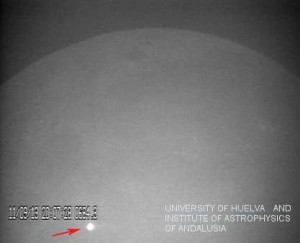WHAM!
A meteorite with the mass of a small car crashed into the Moon last September.
Catching the event were astronomers in Spain, reporting the event in the journal, Monthly Notices of the Royal Astronomical Society.
The impact on the Moon — in Mare Nubium, an ancient lava-filled basin with a darker appearance than its surroundings — produced a bright flash and would have been easy to spot from the Earth.
The unusually long and bright flash was witnessed on September 11, 2013. An afterglow remained visible for a further eight seconds.
MIDAS touch
The Spanish telescopes are part of the Moon Impacts Detection and Analysis System (MIDAS) system that monitors the lunar surface.
This project is being undertaken by Jose Maria Madiedo, from the University of Huelva (UHU), and by Jose L. Ortiz, from the Institute of Astrophysics of Andalusia (IAA-CSIC).
The September event is the longest and brightest confirmed impact flash ever observed on the Moon, according to Madiedo.
New crater formed
Since these impacts take place at huge speeds, the rocks become molten and are vaporized at the impact site instantaneously.
These impacts produce a thermal glow that can be detected from Earth as short-duration flashes through telescopes.
According to the astronomers, the rock slammed into Mare Nubium at about 61,000 kilometers per hour and created a new crater with a diameter of around 40 meters. The impact energy was equivalent to an explosion of roughly 15 tons of TNT.
NOTE: For more information on this event, go to a short clip that shows the impact flash itself, at:
Also, a longer movie that includes an explanation of the impact and the MIDAS observatory can be viewed at:
By Leonard David

